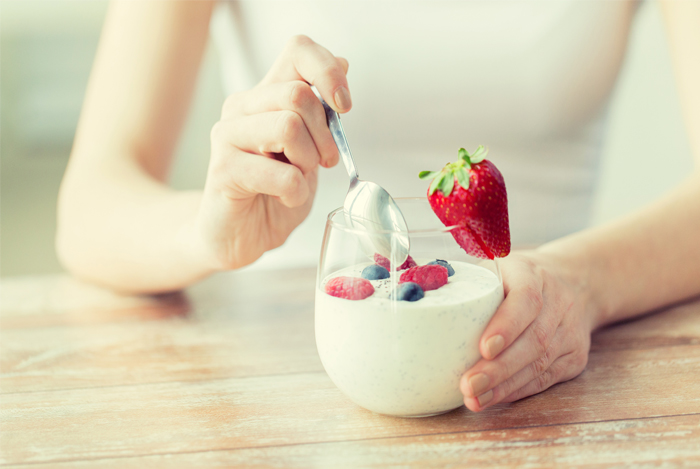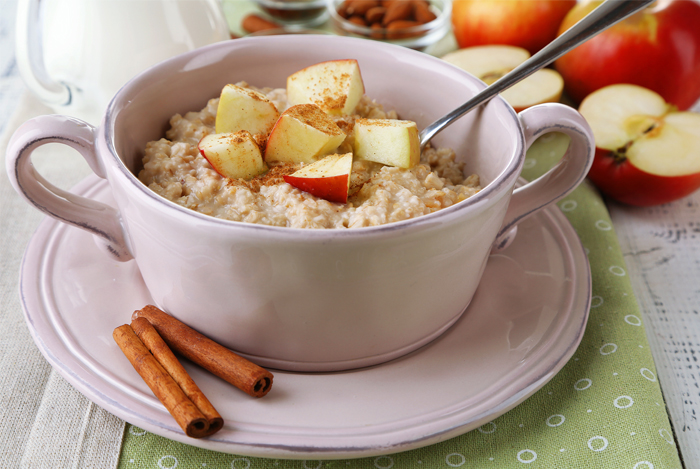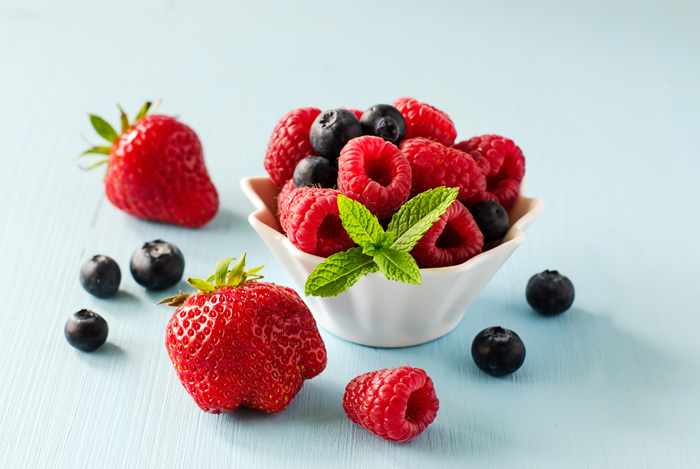Starting your day off with a healthy breakfast can change your life when it comes to improving your health and weight naturally without going on a diet.
Eating something nutrient-dense first thing in the morning also provides you with substantial energy levels for the rest of the day and can even boost your level of mental focus.
But the term “healthy” is a matter of opinion these days.
Everyone has their own idea of what healthy means and food products that advertise themselves to be “healthy” on the front of the package can still be filled with added sugars and excessive amounts of processed fat per serving.
So, if you’re looking for ways to make better choices for your morning meal and possibly lose some weight too, just keep these five rules below in mind each day and the next time you go shopping at the store.
No matter what you choose to eat first thing during the day for breakfast, generally something that falls under the 5 guidelines below will be a winning choice!
1. Pick Something With Protein

Protein is an essential component of a healthy breakfast even if you’re not looking to lose weight or build lean muscle (which it helps dramatically with).
Protein is found in many different foods and helps your body stay energized and focused throughout the morning and early afternoon because the amino acids in certain foods that form protein are used for important neurological functions, hormone functions, and yes, calorie-burning too.
Protein helps curb your hunger levels and it can also help your body absorb more nutrients from the other foods you’re eating because of the way it plays an important part in the overall digestive and absorption process.
However, it’s important to choose sources of protein that digest easily for you. In other words, if you’re not used to eating bacon and eggs for breakfast, don’t go that route just to get in some protein.
Choose a lean source of protein that you enjoy, preferably one that is made from a whole food or that at least contains minimal ingredients without added sugars.
Here are nutrient-dense protein options you could enjoy as part of a healthy breakfast:
- An egg with egg whites
- Nonfat or low-fat plain Greek yogurt
- Oatmeal
- Quinoa
- Hemp protein
- Whey protein
- A protein powder blend made from whole foods
- Homemade veggie burger for a savory breakfast
- Tofu scramble
- Chia seeds
- Hemp seeds
You should also keep in mind that most all plant foods contain protein—not just animal sources, so getting enough protein each morning isn’t too hard.
The grams of protein you eat can also add up quickly, so aim to get in around 15-25 grams of protein for the most filling and calorie-burning benefits. Eating more than that may lead to sluggishness, so there’s no need to go overboard with protein either.
Not into bacon or eggs? Add any of these protein sources to your morning meal that don’t contain meat, dairy, or eggs if you’d like more ideas to make a healthy breakfast!
2. Get Your Fiber Fill

Fiber does many things in your body, but one of the most beneficial things it does is keep you full and satisfied without adding calories to your meals.
Fiber is also one type of carbohydrate just like sugar and starch are, but fiber is the one kind of carb you never want to cut out of your life like you might be looking to limit your intake of starches and sugar.
Why?
Because the calories from fiber aren’t digested by your body. This means the calories from the fiber in oatmeal, an apple, or blueberries, for example, don’t even count towards your total caloric intake.
Fiber from plant foods (the only source of fiber) is also used by the body to eliminate toxins and remove cholesterol from the bloodstream to keep your heart healthy. Fiber also feeds the good bacteria in your digestive tract helping to keep your microbiome in check.
Having at least 5-8 grams of fiber at breakfast is a great place to start if you’re just beginning to add more fiber to your day, but don’t be afraid to go upwards to 10-15 grams if your body can handle it. It’s easier to pack more fiber into your meal than you might think, too.
It’s easier to pack more fiber into your meal than you might think, too. A 1/3 cup of oatmeal has 6 grams of fiber, 1 cup of blueberries has 7 grams, and 1 tablespoon of ground flax has 4 grams. An apple has 4 grams of fiber and a plant-based protein powder, such as hemp protein, may also contain fiber in it too, even up to 12 grams per scoop in some varieties!
You need at least 25-30 grams of fiber per day for optimal health, but you don’t want to get all those grams of fiber in at one meal.
So take it slowly when you add more fiber to your morning meal to be sure that you don’t experience any uncomfortable levels of bloating. Fiber is a pivotal part of losing weight and staying healthy, but that doesn’t mean you should go from eating 0 grams of fiber to 20 grams within a day or two.
Shoot to eat 3 more grams of fiber than you are now and progress by 3 more grams each week until you reach at least 10 grams for breakfast. While there’s no limit to how much fiber you can eat, it’s still smart to take it slowly. Besides, lunch isn’t that long away!
3. Don’t Forget to Eat Something Fresh!

If you’re used to just eating a bowl of oatmeal or some eggs each morning, consider having something fresh like some berries, an apple, or even some greens with your morning meal.
Fresh foods are also important components when it comes to building a healthy breakfast and can also help you feel more energized along with help you lose weight.
Produce is full of vitamins, minerals, amino acids, fiber, and water that will help energize and hydrate you first thing each day. It’s also one of the most important things you can add to your diet when you’re looking to lose weight without limiting portions or counting calories.
A general rule of thumb for adding more fresh foods to your day is to add something fresh to every meal you eat, starting at breakfast. If you can fit in several fresh foods during your morning meal, even better.
Want some healthy breakfast recipe ideas? Here are some tasty options to get you started!
4. Say Goodbye to Sugar

Sugar isn’t just found in candy bars and donuts; it’s also lurking in most granola bars and other packaged breakfast foods like yogurt, cereal, and even some premade oatmeal varieties.
And while sugar may make things taste better initially, it’s also one of the most important things to cut out if you’re looking to eat a healthy breakfast and especially if you’re trying to lose some weight.
Sugar is also one of the easiest things to stop eating once you’ve given yourself enough time to cut it out of your diet (Chocolate, on the other hand, is another story!).
Eating sugary foods is essentially just wasting your calories on nutrient-deficient foods and asking your blood sugar to work harder than it has to.
Sugar intake also leads to disrupted appetite hormone levels so it may also cause you to feel hungrier even if you eat more during your meals or eat more often.
So instead of the super sweet stuff, choose nature’s best source of sugar: fruit! One serving of fruit is a great way to satisfy your body’s needs for some natural sweetness and it’s full of Vitamin C, water, and potassium which are all great for your blood pressure levels.
The fiber in fruit will also help slow down your blood sugar levels and keep your insulin levels stable, but be sure you pair your fruit with a little protein for even more satiety, as mentioned above.
If you’d like another option to sweeten your coffee, tea, oatmeal, or even your yogurt or a smoothie without sugar, consider using some pure, alcohol-free stevia liquid which is made from the stevia herb.
It’s completely calorie-free and one of the few sweeteners that is approved as safe that won’t lead to any known health issues or disrupted blood sugar levels. Some studies even show that stevia can improve digestion, lower blood pressure levels, and stave off bad bacteria in the body.
5. Fear Not, Have a Little Fat

A healthy breakfast doesn’t mean a fat-free one, so be sure to add a little fat from some ground flax, chia seeds, avocado, coconut, or even some eggs if you eat them.
A little fat at breakfast won’t cause you to gain weight, but because it is more calorie-dense, you don’t want to go ham and eat too much of it either. Eat something with just enough fat to add satiety and satisfaction which is around 1-2 tablespoons of whatever fat you choose (or 1-2 eggs).
Even options like plain peanut or almond butter can provide some healthy fats, protein, and they’ll also supply more body with vitamins and minerals that you won’t get from fatty packaged foods or fast food options.
In general, fat does take longer to digest so eating too much may rob you of optimal energy levels, but eating just enough fat can actually improve metabolic function, focus, and may improve your efforts to lose weight if you replace refined foods with sources of healthy fats like those mentioned above.
Want more healthy tips? Check out these 10 dietary strategies for healthier hair, skin, and nails in just a month!
The post 5 Tricks to Make a Healthier Breakfast Without Counting Calories appeared first on Nutrition Secrets.
http://www.nutritionsecrets.com/5-tricks-to-make-a-healthier-breakfast-without-counting-calories/
No comments:
Post a Comment